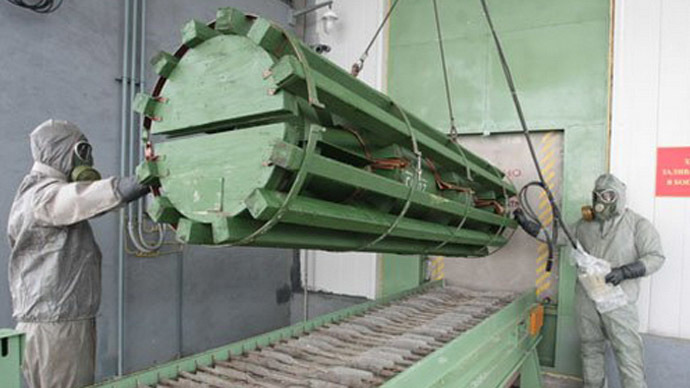
Eurasian Chemical Weapons Threat Persists
Publication: Eurasia Daily Monitor Volume: 10 Issue: 196
By:

In October 2013, Russian authorities reportedly thwarted a possible attack by militant extremists against the Maradykovo chemical weapons (CW) storage and elimination facility in the Middle Volga region of Kirov. The authorities stated that two young males from the North Caucasus allegedly had bomb components and extremist literature in the abandoned house they were occupying (Lentu.ru, October 15, and Newsroom.ru, October 15). Russian authorities are concerned about a terrorist attack to disrupt next February’s Olympic Games in Sochi (see EDM, October 25). Chechen guerrilla leader Doku Umarov has called on the insurgents to employ “maximum force” to prevent the Olympics, seen as a high-prestige project for President Vladimir Putin, from occurring (Kavkaz Center, July 3).
Thanks to foreign aid, higher domestic spending, and popular pressure, the general level of safety of Russia’s chemical stockpiles has improved since Soviet times (when safety was not a priority) and the 1990s (when the new Russian state lacked adequate funding). Nonetheless, the possible planned attack highlights the importance of security measures at CW storage and destruction sites across the former Soviet Union. Russian authorities believe that a successful attack against the facility, which contains the nerve agent Soman, could have claimed hundreds of lives (RT, October 15).
Nearly all the former Soviet republics have had to grapple with the legacy of the massive Cold War–era Soviet chemical weapons program, the largest in world history. According to the Russian government, it inherited more than 40,000 tons of the most dangerous chemical weapons, including blister, choking and, especially deadly, binary nerve agents. These have been stored at seven depots within Russia, where they are being destroyed in special destruction facilities. Like the United States, Russia has repeatedly had to postpone the date for their elimination due to environmental, technical, and financial problems. As of August 2013, Russia had destroyed more than 30,500 metric tons (76 percent) of its original chemical weapons stockpile (RIA Novosti, August 8). Russian officials now aim to destroy their remaining chemical weapons by the end of 2015. Many outside experts believe it could require several more years beyond that date, however, (Global Security Newswire, April 5)
The Tashkent Agreement (https://lawrussia.ru/texts/legal_215/doc215a268x886.htm) of the Commonwealth of Independent States (CIS) designated the Russian Federation as the legal inheritor of Soviet Union’s chemical weapons, and the Russian government moved most chemical weapons stockpiles and related assets to Russian territory during and after the collapse of the Soviet Union and its armed forces. But some declared production and testing facilities remained in the other republics. For example, the Chemical Research Institute established in Nukus, Uzbekistan, was used to make advanced nerve agents (IWPR-RCA, November 14, 2005). In addition, US forces found unanticipated traces of nerve and mustard gas in Uzbekistan, suggesting that other unknown CW stockpiles may exist across the region (Kommersant, June 11, 2002).
All the former Soviet republics have joined the Chemical Weapons Convention (CWC), which prohibits the development, production, acquisition, stockpiling, transfer and use of offensive chemical weapons (https://www.opcw.org/chemical-weapons-convention/). They have worked with the Organization for the Prohibition of Chemical Weapons (OPCW), which administers and verifies the CWC, to eliminate any chemical weapons storage and production facilities on their territories. Unlike in the Middle East, no firm evidence exists that any of the new states that emerged from the former Soviet Union ever used chemical weapons in war. There were allegations that Armenia used chemical weapons against Azerbaijan in 1992, but the United Nations investigated these claims and found no evidence to support them (https://www6.carleton.ca/cctc/ccms/wp-content/ccms-files/CC3.pdf).
Yet, these countries have to worry about the threat that criminals or terrorists will gain access to some of the still massive Russian chemical weapons stockpiles. Compounding the issue, border security remains a problem throughout Eurasia due to corruption, frozen conflicts and ungoverned spaces (see EDM, January 9, May 28), as well as the many trafficking networks that already move people, drugs, and occasionally terrorists across the region’s international boundaries. All the post-Soviet countries have since enacted legislation controlling the production, use and transportation (imports, exports, and movement within the country) of potential chemical weapons, although controls on so-called “dual-use” items (with potential military as well as civilian application) are not as strict (https://archives.sipri.org/contents/expcon/1996kazlaw.html). However, concerns persist about inadequate finances, trained personnel, specialized equipment, and other emergency management capabilities.
The United States, the European Union and the United Nations have been pursuing programs to help these countries control and eliminate these stockpiles. This has been particularly notable in Central Asia. For example, the 2010 Steppe Eagle Exercise with North Atlantic Treaty Organization (NATO) countries rehearsed the ability of Kazakhstan’s peacekeeping battalion and brigade headquarters to respond to a CW attack (States News Service, September 16, 2010). Moreover, at a February 2012 training event at the Manas Transit Center in Kyrgyzstan, US and Kyrgyzstani personnel exchanged information on explosive ordnance disposal and chemical, biological, radiological, nuclear and high-yield explosives response (US Air Force, February 26, 2012).
Looking ahead, these countries will need to keep their national laws and regulations updated as their domestic chemical industries continue to develop. The Russian government has launched a long-term plan to revitalize its civilian chemical industry by adopting the most advanced technologies and industry practices (https://eng.kremlin.ru/transcripts/6124). Kazakhstan is also seeking to develop a sophisticated chemical and nanotechnology sector as part of its industrial diversification efforts. Under its Chemical Industry Development Plan for 2011–2019, Astana is planning to invest more than $9 billion in chemical manufacturing from 2011 to 2015 alone (GlobalTrade.net, April 20, 2011)
If the former Soviet republics succeed in developing more advanced chemical, nanotechnology, and other sophisticated sectors, these new dual-use capabilities could present even more serious proliferation challenges since they could be used to create new forms of deadly bio-toxins and miniaturized CW delivery systems. Therefore, their continued cooperation with the OPCW and other bodies will be essential to establish appropriate national legislation and export controls before they acquire these new capabilities.




